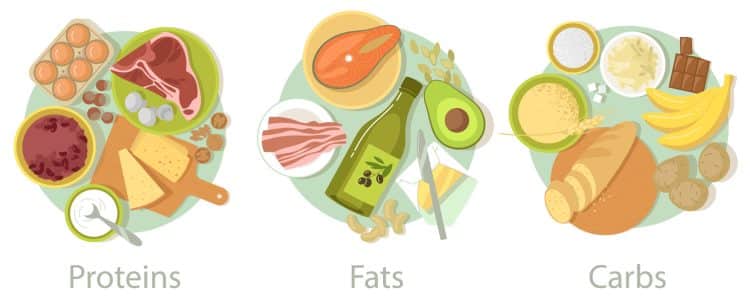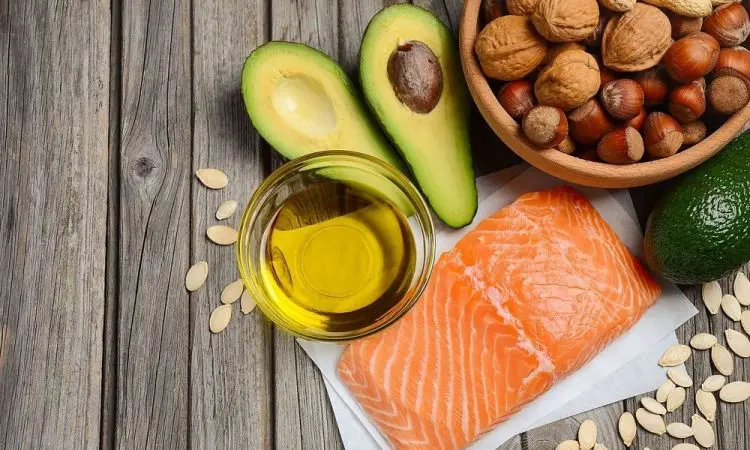It’s often said that you are what you eat. The food you consume essentially becomes part of you at a cellular level, and it has a profound effect on how you look and feel. A good diet that provides your body with the nutrients it needs will make reaching your fitness goals easier.
In contrast, an unhealthy diet could mean you never reach your goals, even if you train hard and consistently. As another saying goes, you can’t out-train a bad diet.
However, it’s also possible to eat healthily and still not make the progress you want. That’s because even healthy foods contain varying amounts of the three nutrient groups – protein, carbohydrate, and fat.
By manipulating your intake of these three nutrients, you can adjust your “fuel mix” to maximize your progress.
In this article, we reveal how to track these nutrients and the best nutrient ratios for the three most common fitness goals.
Macronutrients 101
Level Up Your Fitness: Join our 💪 strong community in Fitness Volt Newsletter. Get daily inspiration, expert-backed workouts, nutrition tips, the latest in strength sports, and the support you need to reach your goals. Subscribe for free!
Macronutrients, or macros for short, is the collective term for the three food groups – protein, carbohydrate, and fat. Macro means big, and you need these food groups in pretty large amounts as they provide your body the calories it needs for energy.
However, as well as being sources of calories, protein, carbohydrates, and fats also play additional roles in the functioning of your body.
Protein
Protein contains four calories per gram. It’s the main dietary source of the building blocks of life – amino acids. Your body uses amino acids like a construction worker uses bricks, and they’re crucial for muscle repair and growth.
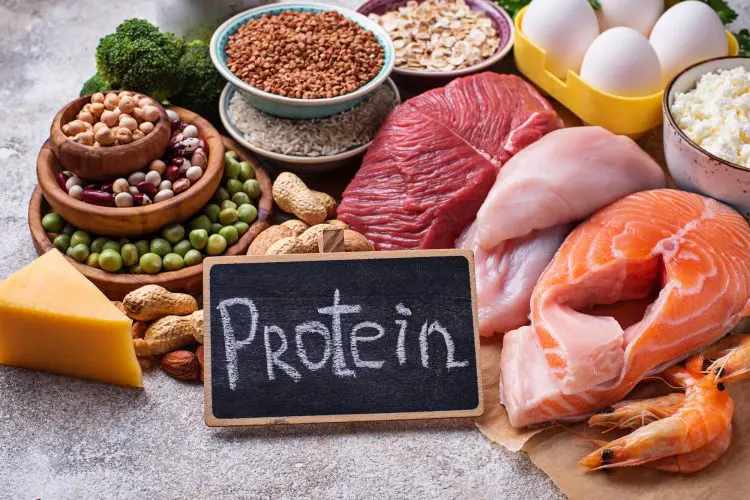
Related: Our List of 40 Great Protein-packed Foods
Intense workouts cause muscles breakdown, which is a process called catabolism. When you rest, and if you consume adequate dietary protein, your body repairs this damage, so your muscles grow back bigger and stronger. We call this process anabolism. Eating too little protein will undermine your progress.
As well as being essential for muscle hypertrophy or growth, protein is helpful for weight loss, too. Eating protein increases your metabolic rate, which is the number of calories you burn per 24 hours at rest. It’s also satiating (filling) and can help prevent the muscle breakdown often associated with weight loss diets.
Check out our favorite quality protein powder supplements.
Protein recommendations vary enormously, from 0.8 grams per kilogram of bodyweight, right up to two grams or more per kilo. Generally, the more active you are, the more protein you need.
Determine your protein needs using our online protein calculator.
Carbohydrates
Like protein, carbohydrates contain four calories per gram. Often known as carbs, this food group is your body’s primary energy source during intense physical activity. Carbs are broken down into glucose to be used as a fast-acting source of energy, and excess carbs are converted to and stored as fat. The speed at which carbs are converted into glucose is determined by something called the glycemic index, and some carbs are faster acting than others.
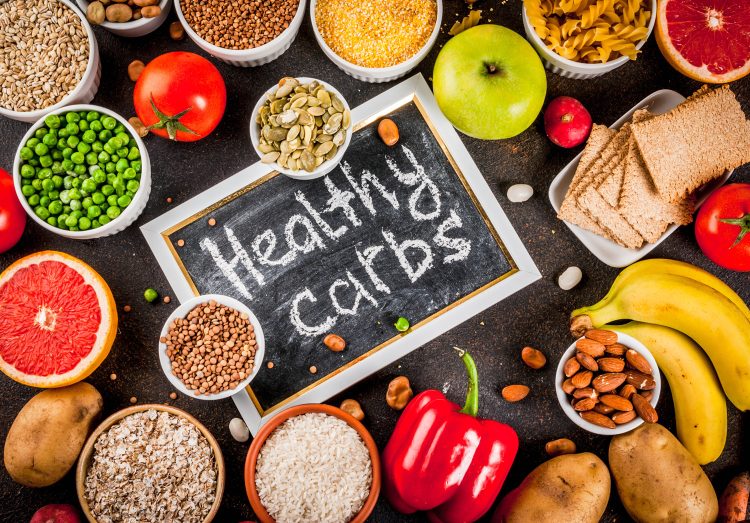
In general, the more physically active you are, the more carbs your body needs and can tolerate. However, a high-carb diet combined with a sedentary lifestyle is a recipe for weight gain.
Carbs can be refined or unrefined, and generally, unrefined carbs are healthier. These are usually foods that have been minimally processed. Unrefined carbs are higher in essential vitamins and minerals, which are collectively called micronutrients.
Vitamins and minerals are biological catalysts for the reactions that keep your body functioning correctly. This includes immunity, skin health, muscle contractions, and maintaining a regular heartbeat. A lack of vitamins and minerals can quickly lead to poor health.
Carbs are also your dietary source of fiber. There are two types – soluble and insoluble – and both are crucial for digestive health. They also play an important role in regulating your blood glucose. Fiber can even mop up trace amounts of fat and cholesterol. High-fiber foods, such as oats, vegetables, and fruit, are also linked to improved cardiovascular health.
Use this calculator to determine your ideal carb intake.
Fats
Fats are a controversial nutrition topic, with some people thinking they’re healthy, while others believe fats are best avoided. The truth is somewhere in between. Fats contain nine calories per gram, so eating a lot of fat could put you into a calorie surplus, resulting in weight gain.
However, natural fats are largely healthy, and your body uses them for fuel and other essential bodily functions. The three types of fat are:
- Saturated
- Monounsaturated fats
- Polyunsaturated fats
That said, it’s best to avoid manmade and heavily processed fats. Known as trans fats, this type of fat is linked to many health problems, including heart disease, diabetes, and obesity (1). Sources of trans fats include baked goods, takeouts, and potato chips.
The good news is trans fats are banned in the US, but that may not be the case in other parts of the world (2). Trans fats are also produced when mono and polyunsaturated fats are exposed to high temperatures, air and light, so there is still a chance they’re in your diet, even if you don’t consume them. Either way, trans fats are unhealthy and definitely best avoided.
So, most people should eat at least some fat, but too much could lead to weight gain. It’s best to avoid sources of manmade and processed fats as the trans fats they contain could harm your health.
Alcohol
With seven calories per gram, alcohol isn’t really a macronutrient because it isn’t essential to life. That said, because it contains calories, it’s important to monitor your alcohol intake to avoid derailing your diet. The calorie content of alcoholic drinks can vary enormously. For example, a shot of vodka contains just under 100 calories. However, a large beer has over 200.
If you do drink alcohol, make sure you take the calorie value of each drink into account when you are calculating your energy intake and macros.
How to Calculate your Macros
To gain weight, you need to consume more calories than you expend. This creates a calorie surplus, which your body will use to fuel muscle growth. However, consume too many calories, and you’ll gain fat too.
To lose fat, you need to consume fewer calories than you expend. This creates a calorie deficit. Faced with this energy shortfall, your body will burn fat to make up the difference.
Level Up Your Fitness: Join our 💪 strong community in Fitness Volt Newsletter. Get daily inspiration, expert-backed workouts, nutrition tips, the latest in strength sports, and the support you need to reach your goals. Subscribe for free!
But, you’ll get better results from your diet and workout regimen if you adjust your macro ratios, which is the relationship between your intake of protein, carbs, and fat. In some instances, a lower carb and higher protein intake will lead to better results. In others, eating more carbs may be helpful. All this is covered in the next section!
And how do you know how much protein, carbohydrate, and fat you are eating?
Back in the old days (well, about 20 years ago), if you wanted to know how much protein, carbohydrate, and fat you were eating, you bought a book that listed the breakdown for popular foods.
You then weighed the ingredients of your meals, broke out your calculator, and worked it all out by hand. Needless to say, this was VERY laborious!
More recently, online databases of foods have made this process somewhat easier. However, you still need to look up each food individually and then add them together to make your meals.
Thankfully, macro tracking got much simpler with the advent of meal tracking apps. Simply type your food or meal into the app, tell it how much you’ve eaten, and you’ll instantly get a breakdown of your protein, carb, and fat intake. Most track vitamins, minerals, and fiber, too.

However, you will still need to weigh your food to get an accurate breakdown. This can be a bit time-consuming initially, but you’ll soon see that you eat the same meals and foods repetitively. So, once you’ve saved a food or meal to your list of favorites, it’ll be easy to find next time. This makes ongoing macro tracking much more straightforward.
There are lots of great apps for macro tracking, including:
- MyFitnessPal
- LoseIt
- Chronometer
- Spark People
- Fat Secret
Whichever way you do it, and once you have determined your daily calorie requirements, tracking and manipulating your macro intake could help you reach your goals faster and more easily, be that fat loss or building muscle.
Macro Ratios by Goal
You can make a car engine more economical by tweaking the ratio of fuel and oxygen. Similarly, you can increase performance by using a different fuel mix. Your body is similar in that adjusting your macro ratios will affect your metabolism (3).
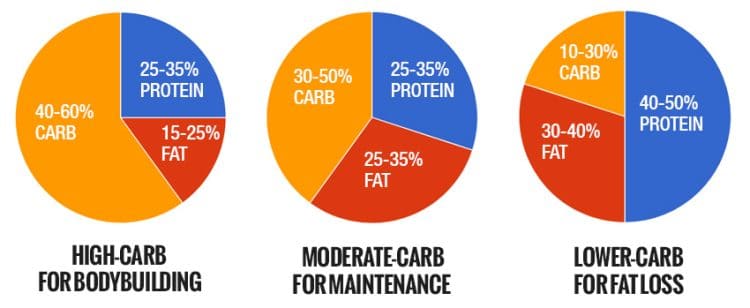
There are lots of different ratios to choose from. And no, there is no such thing as the perfect macro ratio because people respond differently to the food they eat. Things like carbohydrate tolerance and insulin sensitivity can vary from person to person. Your choice of workout will also determine the best macro ratio.
That said, here are the accepted ratios for three different training goals. However, remember that while controlling your calorie intake and adjusting your macros should help you make faster progress, food quality is still important.
Building muscle
To build muscle, you need plenty of carbs to fuel your intense workouts, adequate protein for muscle repair and growth, and still need some fat for more energy and health.
Many bodybuilders make the mistake of consuming too much protein, often at the expense of their carb intake. Your body can only utilize a finite amount of protein, and eating more doesn’t automatically mean more muscle growth.
For bodybuilding, try and hit the following macro ratios/ranges:
- Protein: 25-35%
- Carbs: 40-60%
- Fat: 15-25%
Losing fat
While losing fat is mainly the result of eating fewer calories, cutting carbs can also help. You don’t have to eliminate carbs entirely, as you would on the ketogenic diet. However, reducing your carb intake will help lower your blood glucose and force your body to use even more fat for fuel. Consuming more protein will also help increase your metabolic rate.
The ideal macro ratios for fat loss are:
- Protein: 40-50%
- Carbs: 10-20%
- Fat: 30-40%
Maintenance
Suppose you are currently happy with your weight and want to stay that way. In that case, you should consume similar amounts of protein, carbohydrates, and fat. This is called an isocaloric diet – iso meaning equal. Many diets recommend splitting your macros evenly, including the Zone, which is the diet most commonly associated with CrossFit.
To maintain your current weight and body fat, use these macros:
- Protein: 25-35%
- Carbs: 30-50%
- Fat: 35-35%
Alternatively, for a more individualized macro prescription, use our online macronutrient calculator. This easy-to-use tool does it all; it determines how many calories you need to eat and reveals the ideal macro ratio based on your goals.
Remember, though, while hitting your calorie and macro targets are important, food quality matters too. Try to eat as healthily as you can while hitting your macronutrient goals to get even more from your diet while improving your general health.
Related:
- How to Burn 400 Calories a Day
- How to Burn 1000 Calories A Day
- Fat vs. Muscle Weight: How to Tell the Difference
- How To Lose 1 Pound a Day
- How To Lose 15 Pounds in a Month
- Losing 50 Pounds in 6 Months
- How to Lose 10 Pounds in a Week
Calculate Macros – Wrapping Up
With all this information and these tools at your disposal, determining and hitting your macros still won’t be easy. After all, you’ll have to manipulate your meals so they contain the right amounts of protein, carbs, and fat. That can be both tricky and frustrating.
So, instead of aiming for perfection, shoot for consistency instead. Get as close to your macro targets as you can without losing your mind over trying to achieve absolute accuracy; it’s just not possible!
Over time, you’ll gradually move toward your goals, even if your macro intake is out by few grams or a couple of percent. In the end, consistency is the most significant factor determining your success when tracking your macros.
References:
1 – PubMed:Trans Fats—Sources, Health Risks, and Alternative Approach – A Review https://www.ncbi.nlm.nih.gov/pmc/articles/PMC3551118/
2 – Harvard School of Public Health: Artificial trans fats banned in U.S. https://www.hsph.harvard.edu/news/hsph-in-the-news/us-bans-artificial-trans-fats/
3 – PubMed:Utilizing Dietary Nutrient Ratios in Nutritional Research: Expanding the Concept of Nutrient Ratios to Macronutrients https://www.ncbi.nlm.nih.gov/pmc/articles/PMC6413020/

